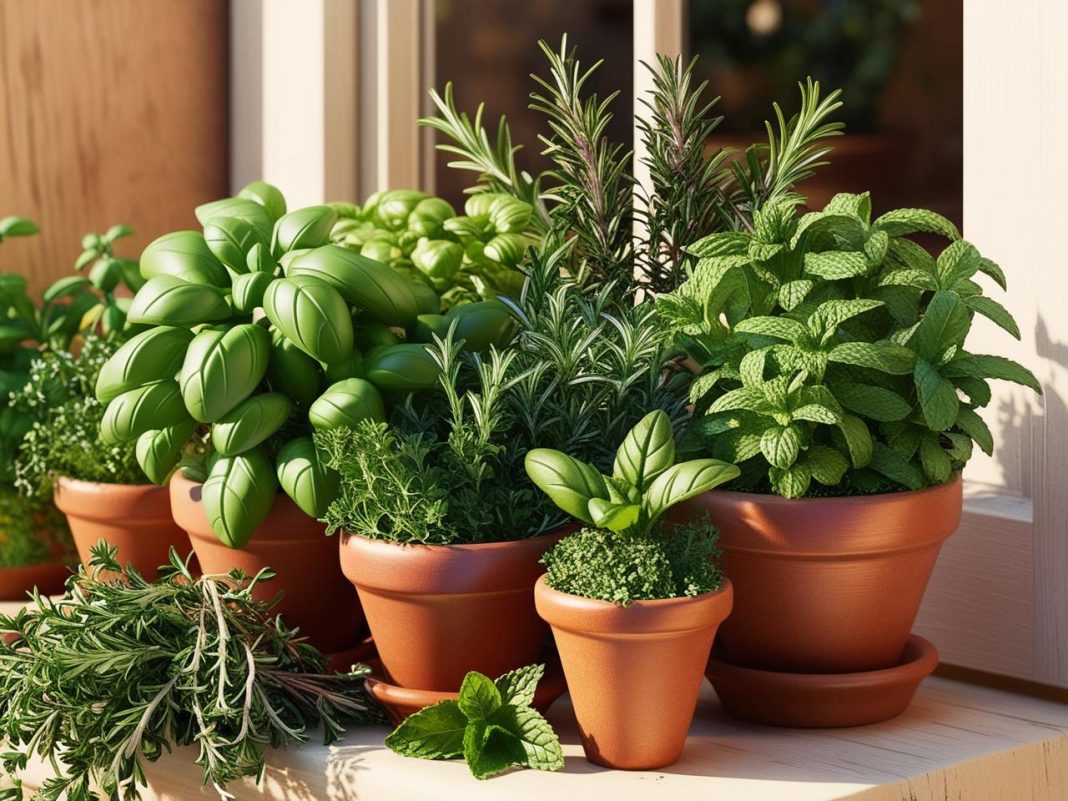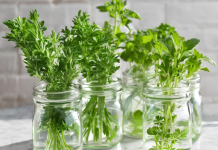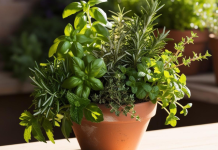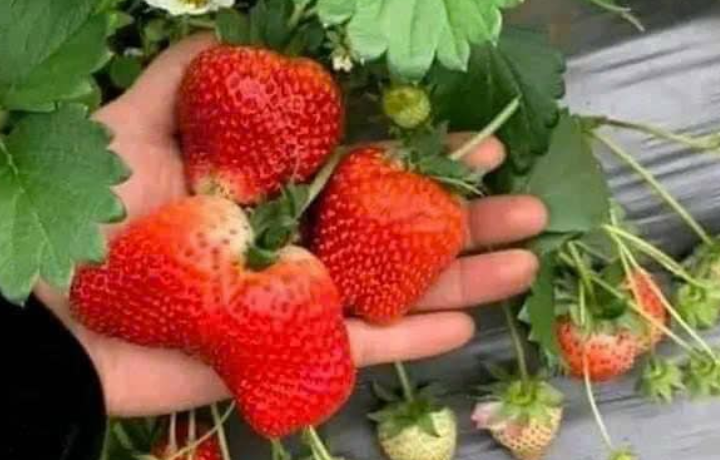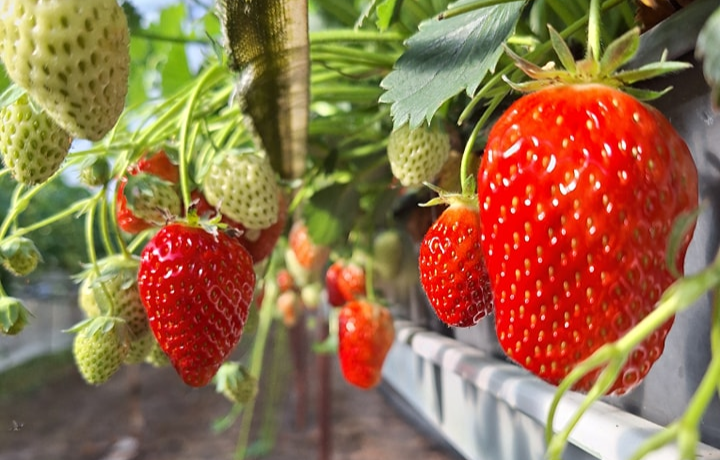If you’ve ever wanted to grow your own fresh herbs but weren’t sure where to start, you’re in the right place! Learning how to start a mini herb garden at home is a great way to enjoy fresh flavors in your cooking, improve your health with natural remedies, and even enhance the beauty of your home or garden. Whether you have a small apartment or a spacious backyard, creating a mini herb garden is an accessible and rewarding project for anyone, from beginners to experienced gardeners.
In this guide, we’ll walk you through the basics of planting, caring for, and troubleshooting common issues in your herb garden. From selecting the right herbs like thyme, mint, and oregano to choosing the perfect space—whether indoors or outdoors—you’ll learn everything you need to get started. The benefits of having your own herb garden are vast, offering convenience in the kitchen, beauty in your surroundings, and a calming hobby that connects you with nature.
So, if you’re ready to get your hands a little dirty and start growing your own delicious, aromatic herbs, keep reading to find out how to start a mini herb garden at home!
Why Start with Herbs?
Herbs are an excellent choice for beginner gardeners. Here’s why they’re the perfect starting point:
- Versatility: Herbs adapt to various growing conditions, thriving indoors on windowsills, outdoors in pots, or directly in garden soil. Whether you have a sunny balcony or a shaded corner, there’s an herb that can flourish in your environment.
- Low Maintenance: Many herbs, such as rosemary, thyme, and mint, are hardy and forgiving. They require minimal care, making them ideal for those new to gardening. A bit of sunlight, occasional watering, and well-draining soil are often enough to keep them thriving.
- Multiple Uses: Herbs are multifunctional. Use them to enhance your culinary creations, prepare soothing teas, or create homemade remedies. Some herbs, like lavender and basil, also act as natural pest repellents, adding another layer of utility to your mini garden.
- Compact Size: Herbs are naturally compact, fitting perfectly into small spaces. They’re great for apartment dwellers or anyone looking to add greenery to limited areas, such as windowsills, countertops, or small patios.
- Cost-Effective: Starting with herbs doesn’t require a significant investment. Seeds and starter plants are affordable, and many herbs grow quickly, providing a sustainable source of greenery and flavor for months to come.
- Educational Opportunity: Growing herbs provides an excellent learning experience. Observing their growth patterns, experimenting with propagation techniques, and understanding their care needs can serve as a stepping stone to more complex gardening projects.
- Aesthetic Appeal: Herbs like parsley, dill, and sage have unique textures and vibrant colors that add visual interest to your space. They can be arranged in creative ways to enhance the decor of your mini garden.
- Quick Results: Many herbs grow rapidly, giving beginners the satisfaction of seeing their efforts pay off in a short time. For example, cilantro and basil can be ready to harvest in just a few weeks.
- Sustainability: By growing your own herbs, you reduce the need for store-bought ones, cutting down on packaging waste and transportation emissions. This makes herb gardening an eco-friendly choice.
With their versatility, ease of care, and multitude of benefits, herbs are an excellent gateway into the world of gardening. Whether you’re growing them for their flavor, fragrance, or functionality, they’ll enrich your space and your life in countless ways.
Overcoming Common Concerns
Many people worry about starting a garden, thinking they lack the skill or space. Here are some common concerns and solutions:
- “I have a black thumb.” Start with hardy herbs like thyme, mint, or oregano that are difficult to kill. These plants can tolerate neglect and still thrive, giving you the confidence to expand your garden later.
- “I don’t have enough space.” Use windowsills, balconies, or small pots. Even the tiniest spaces can accommodate a few pots or hanging planters. Vertical gardening options also help make the most of limited areas.
- “I’m afraid I’ll overwater.” Learn to check soil moisture by sticking your finger 2 inches into the soil. If it feels dry, it’s time to water. You can also use self-watering pots to minimize the risk of overwatering.
- “I don’t know what to grow.” Begin with 4–5 perennial herbs that are easy to care for. Basil, parsley, chives, and dill are excellent options for beginners due to their resilience and usefulness in cooking.
- “I’m worried about pests.” Some herbs, like lavender and rosemary, naturally repel pests. Introducing these plants into your mini garden can help keep unwanted insects at bay without the need for chemicals.
- “I don’t have time.” Choose low-maintenance plants that require minimal care, such as succulents or hardy herbs. Setting up an automated watering system can also save you time and effort.
- “I lack proper sunlight.” Grow light setups are an easy solution for indoor gardening. Herbs like mint and parsley can also tolerate lower light levels, making them suitable for shadier spots.
- “I’m on a budget.” Start with seeds or cuttings instead of fully grown plants. Many herbs, like basil and mint, propagate easily from cuttings, allowing you to expand your garden without additional costs.
- “I travel frequently.” Opt for drought-tolerant plants like rosemary or succulents, which can survive with infrequent watering. Self-watering planters are another great option for travelers.
- “I’m unsure about soil and pots.” Use all-purpose potting soil for most herbs and ensure your pots have good drainage holes. Repurposing containers, like jars or cans, is a cost-effective and sustainable option.
Gardening doesn’t have to be intimidating. With the right plants, tools, and mindset, anyone can enjoy the rewards of a thriving mini garden.
Understanding Gardening Zones
What Are Gardening Zones?
Gardening zones refer to your local climate, which affects what plants will thrive. For outdoor gardening, knowing your zone helps you select the right herbs.
- Indoor Gardening: Zones matter less if you’re growing herbs indoors, as you control the environment. However, understanding the natural preferences of your plants can still be beneficial for things like temperature and humidity.
- Outdoor Gardening: Choose herbs suited to your zone to ensure success. For example, Mediterranean herbs like rosemary and lavender thrive in warmer zones, while chives and parsley do well in cooler climates.
How to Identify Your Zone:
- Check online gardening zone maps provided by local agricultural extensions or gardening websites.
- Most seed packets and plant labels indicate the suitable zones for a particular plant, so be sure to reference these before purchasing.
- Use mobile apps or gardening tools that can pinpoint your zone based on your location.
Adapting to Your Zone:
- If you live in a colder zone, consider growing herbs in pots so they can be brought indoors during frost.
- For warmer zones, ensure proper irrigation and shade during scorching summer months to prevent plants from wilting.
- Use mulch to regulate soil temperature and retain moisture, especially in zones with extreme weather fluctuations.
Microclimates:
- Even within a single zone, microclimates (areas with slightly different conditions) can exist. For example, a south-facing wall may be warmer and suitable for sun-loving herbs, while shaded areas may support more delicate plants.
Gardening zones are a helpful guideline, but they’re not a strict rule. By understanding your local climate and the needs of your plants, you can create a thriving mini garden regardless of where you live.
Choosing Your Herbs
Herbs are versatile additions to your garden, offering culinary, medicinal, and aesthetic benefits. Whether you’re a beginner or an experienced gardener, understanding the needs of your herbs ensures they thrive. Here’s a breakdown of options based on their hardiness and care requirements:
Hearty Perennial Herbs
These herbs are low-maintenance and return year after year, making them perfect for beginners:
- Thyme: A hardy herb that flourishes in most conditions. Its earthy flavor complements soups, roasted vegetables, and meats. Medicinally, it’s known for antibacterial and antifungal properties.
- Oregano: A robust and aromatic herb used in Italian and Mediterranean cuisine. Try different varieties like Greek or Italian oregano for unique flavors.
- Rosemary: This evergreen herb is drought-tolerant and a favorite for roasted dishes and breads. It’s also valued for its ability to improve memory and circulation.
- Mint: A prolific grower, mint spreads rapidly and thrives in partial shade. Perfect for teas, mojitos, and as a natural pest deterrent, mint needs containment to prevent overgrowth.
- Lemon Balm: With its citrusy scent and soothing properties, lemon balm makes an excellent tea herb and natural remedy for stress and colds.
Semi-Hearty Herbs
These herbs require a bit more care but are still manageable for most gardeners:
- Sage: A beautiful herb with velvety leaves. Its earthy, slightly peppery flavor enhances savory dishes like stuffing and sauces.
- Parsley: This versatile herb adds freshness to numerous recipes. Curly parsley is more robust and cold-resistant than flat-leaf varieties.
- Chives: With a mild onion flavor, chives are a great addition to soups, scrambled eggs, and dips. Their purple blossoms also attract pollinators to your garden.
- Aloe: Though not a culinary herb, aloe is a must-have for its soothing gel, ideal for burns and skin care. It thrives indoors in sunny spots.
“Princess Herbs”
Delicate and temperamental, these herbs require specific conditions but are well worth the effort:
- Basil: A beloved herb in cuisines worldwide, basil thrives with consistent watering and warm weather. Purple basil is slightly hardier and adds visual appeal.
- Cilantro: This herb is polarizing for its flavor—citrusy to some, soapy to others. It grows quickly but bolts in hot weather, so regular replanting or shade can help extend its lifespan.
Choosing the right herbs depends on your climate, garden space, and the level of care you’re willing to provide. Start with hearty perennials, experiment with semi-hearty varieties, and eventually tackle the more delicate “princess” herbs for a well-rounded herb garden.
Preparing Your Space
Proper preparation of your gardening space is essential for healthy plant growth, whether you’re gardening indoors or outdoors. The right location, tools, and conditions set the foundation for a thriving herb garden. Here’s how to set up your space:
Indoor Gardening
Indoor herb gardening allows you to grow fresh herbs year-round, regardless of the season. Here’s how to prepare your space indoors:
- Choose a Sunny Windowsill: Most herbs need at least 6 hours of sunlight per day, so pick a location near a south- or west-facing window. If sunlight is limited, consider using a grow light.
- Use Pots with Drainage Holes: To prevent overwatering and root rot, always choose pots that have drainage holes. Excess water should be able to escape, ensuring your plants don’t sit in soggy soil.
- Ensure Good Air Circulation: Stale air can promote mold and mildew growth. Make sure your indoor garden area has adequate ventilation. You can use a small fan or regularly open the window to allow fresh air circulation.
- Monitor Temperature: Herbs generally prefer temperatures between 65°F and 75°F. Avoid placing your pots in areas with extreme temperature fluctuations, like next to heaters or air conditioners.
Outdoor Gardening
Outdoor gardening provides more space for herbs to grow freely. Here’s how to prepare your garden space outdoors:
- Select a Sunny Spot with Filtered Light: While herbs need sunlight, too much direct sunlight can scorch delicate plants. Choose a spot that offers a balance of sunlight and light shade, especially during the hottest part of the day.
- Test Your Soil for pH and Nutrient Levels: Herbs thrive in slightly acidic to neutral soil (pH 6.0 to 7.0). Use a soil test kit to determine the pH and nutrient levels of your garden soil. Based on the results, you may need to amend the soil.
- Add Compost or Organic Potting Soil: Enrich your soil with compost or organic potting mix. This will improve soil structure, drainage, and nutrient levels, ensuring your herbs have everything they need to grow.
- Consider Raised Beds or Ground Planting: If your soil is poor or if you want to improve drainage, raised beds are a great option. Alternatively, you can plant directly in the ground if the soil is well-draining and nutrient-rich. Raised beds also reduce the risk of soil compaction, making it easier for roots to grow.
By thoughtfully preparing your space, you’re setting the stage for healthy, productive herbs. Whether growing indoors or outdoors, creating the right environment will ensure that your herbs thrive and flourish throughout the year.
Planting Your Herbs
Successfully planting your herbs is a crucial step toward creating a thriving garden. Whether starting from seeds or baby plants, each method has its own set of considerations for optimal growth. Here’s how to plant your herbs properly:
Planting From Seeds
Starting herbs from seeds can be a rewarding experience, but it requires patience and attention to detail.
- Prepare the Soil: Use a high-quality organic potting mix that has good drainage to avoid waterlogging. Herbs prefer slightly loose, well-drained soil to allow their roots to grow freely.
- Plant Seeds at the Recommended Depth: Each herb seed has a specific depth at which it should be planted. Check the seed packet for instructions on planting depth, which typically ranges from 1/4 inch to 1 inch, depending on the variety.
- Water Gently: Mist the soil gently with a spray bottle twice a day. Keep the soil consistently moist but not soggy until the seeds germinate. Overwatering can lead to root rot and mold, so use a light hand.
- Provide Warmth: Most herb seeds need warmth to germinate. Maintain a temperature range between 65°F and 75°F for the best results. If necessary, use a seedling heat mat to regulate temperature.
Planting From Baby Plants
Transplanting baby plants into your garden or containers is faster and more forgiving than starting from seeds.
- Choose Healthy Plants: Select baby plants with vibrant, green leaves and sturdy stems. Avoid any with yellowing or wilting leaves, as these could indicate health problems.
- Transplant Carefully: Gently loosen the roots of the plant before transplanting. Avoid pulling on the stems, as this can damage the plant. If the roots are pot-bound, tease them apart gently with your fingers.
- Plant at the Correct Depth: When planting baby plants, make sure the root ball is at the same level as the surrounding soil. Planting too deep or too shallow can hinder growth.
- Water Thoroughly: After transplanting, water the plants thoroughly. Ensure the soil is evenly moist, but not waterlogged. It’s important to provide enough water to help the plant settle into its new environment.
Whether starting from seeds or baby plants, your herbs need a little time and care to establish roots and grow strong. Following these planting guidelines will give your herbs the best start, ensuring a healthy and bountiful harvest.
Caring for Your Herb Garden
Proper care is essential for healthy herb growth, whether you’re growing indoors or outdoors. A few key practices, including watering, sunlight, and pruning, will help your herbs thrive and ensure a productive garden. Here’s how to care for your herb garden:
Watering Tips
Watering is one of the most important aspects of herb care. Too little or too much water can harm your plants.
- Check Soil Moisture: Insert your finger about 2 inches deep into the soil to gauge moisture levels. If the soil feels dry at that depth, it’s time to water.
- Water When Dry: Water your herbs when the soil feels dry to the touch. However, avoid overwatering, which can lead to root rot and other issues. Ensure that excess water can drain away from the pot or soil.
- Gentle Watering for Indoor Herbs: For indoor herbs, use a spray bottle or a gentle watering can to avoid flooding the soil. Misting helps maintain the right moisture balance and prevents soil from becoming too compacted.
- 10 Indoor Grow Tents: A Comprehensive Guide for Plant Enthusiasts
- Unlock the Full Potential of Your Instant Pot: Essential Accessories to Enhance Your Cooking Experience
Sunlight Requirements
Proper sunlight is crucial for healthy herbs. Each herb has its specific light needs, but most herbs thrive with plenty of sun.
- Full Sun: Most herbs, such as basil, rosemary, and thyme, thrive in full sunlight and need 6–8 hours of direct sunlight each day. Place them in sunny spots to ensure vigorous growth.
- Partial Shade: Some herbs, like mint, parsley, and cilantro, can tolerate partial shade. These herbs still need some sunlight but can thrive with indirect or filtered light, especially in hotter climates.
Pruning and Harvesting
Regular pruning and harvesting not only help keep your herb plants healthy but also ensure a continuous supply of fresh herbs.
- Trim Regularly: Regular pruning encourages new growth and prevents herbs from becoming leggy. Trim the tops of the plants to promote bushier, fuller growth.
- Harvest in the Morning: For the best flavor, harvest herbs early in the morning, when the essential oils are most concentrated. This is especially important for aromatic herbs like basil and mint.
- Avoid Over-Harvesting: Don’t harvest too much at once. Leave enough leaves on the plant so it can continue to grow and produce more leaves. Over-harvesting can stress the plant and hinder regrowth.
By following these simple steps for watering, sunlight, and pruning, you’ll ensure that your herbs remain healthy, flavorful, and productive throughout the growing season. Careful attention to these basics will lead to a thriving herb garden full of fresh, aromatic plants ready for use in your kitchen.
Troubleshooting Common Issues
Even the healthiest herb gardens can experience occasional problems. Being able to identify and address issues early ensures the health of your plants. Here are common problems and how to solve them:
- Wilting Plants: Wilting can be caused by either overwatering or underwatering. Check the soil moisture—if it’s soggy, reduce watering, and if it’s dry, increase water frequency.
- Yellowing Leaves: Yellow leaves often indicate a watering issue or nutrient deficiency. Adjust your watering schedule and check your soil for proper drainage. Test the soil for essential nutrients like nitrogen, which may need to be replenished.
- Pests: Pests like aphids, whiteflies, and spider mites can damage your herbs. Use natural remedies such as neem oil to treat pest infestations, or plant companion herbs like basil or marigolds to deter unwanted insects naturally.
By closely monitoring your plants for these common signs, you can make timely adjustments and maintain a healthy, thriving herb garden.
The Benefits of Herbal Gardening
Herbal gardening offers numerous benefits, both for personal use and the environment. Here’s why cultivating herbs is a worthwhile endeavor:
- Personal Use: Freshly grown herbs enhance the flavors of your cooking and provide easy access to natural remedies for health. You can make soothing teas, boost your meals with vibrant flavors, or create homemade skincare treatments.
- Environmental Impact: Growing your own herbs helps reduce food waste and packaging. Herbs like mint and thyme also attract and support beneficial pollinators, contributing to a healthier ecosystem.
- Aesthetic Appeal: Herbs add beauty to any space, whether in pots on a windowsill, hanging baskets, or in garden beds. Their lush greenery and colorful blooms bring a natural charm to your home or garden.
- Therapeutic Value: Gardening itself is a calming, therapeutic activity that reduces stress. The process of tending to plants and watching them grow offers a rewarding and relaxing experience.
- Educational Opportunities: Herb gardening provides valuable lessons about plant care, growth cycles, and ecosystems. It’s a great way to learn about sustainable gardening practices while gaining a deeper appreciation for nature.
By growing your own herbs, you gain much more than just fresh ingredients—you nurture your well-being, support the environment, and enjoy a deeper connection with nature.
Recap and Final Tips
Starting your own herb garden is a rewarding and enjoyable experience, but it’s important to approach it with patience and care. Here are some final tips to help ensure your success:
- Start Small: Begin with 4–5 hearty herbs, such as thyme, mint, and oregano. These are easy to grow and perfect for beginners, giving you a manageable foundation.
- Choose the Right Space: Whether you’re gardening indoors or outdoors, make sure to select a space that suits your resources. Consider sunlight, temperature, and space availability when choosing your spot.
- Be Patient and Consistent: Gardening requires time, and results don’t happen overnight. Be patient with your plants, providing consistent care through watering, pruning, and sunlight.
- Learn from Mistakes: Don’t worry if things don’t go perfectly at first. Every gardener makes mistakes, and each one is a valuable learning opportunity.
- Enjoy the Process: Gardening is as much about the journey as the harvest. Take pleasure in watching your herbs grow and thrive, and enjoy the rewards of fresh, homegrown herbs in your kitchen and home.
By starting small, staying consistent, and learning as you go, you’ll soon be enjoying a thriving herb garden that’s both beautiful and useful.
Conclusion
Starting an herb garden is an enriching experience that brings both practical and personal rewards. By selecting hearty herbs like thyme, mint, and oregano to begin with, you set yourself up for success and growth. Whether you choose to plant indoors or outdoors, ensuring the right environment and care will allow your herbs to flourish.
Be patient with your plants and allow them time to grow, as consistent care is key to thriving herbs. Remember, gardening is a learning process, and mistakes are just opportunities to grow in your gardening journey. Whether you’re cooking with fresh herbs, using them for health benefits, or simply enjoying their beauty, the rewards are plentiful.
Ultimately, an herb garden offers more than just fresh ingredients—it provides a therapeutic and fulfilling activity that connects you to nature. With the tips and guidance provided, you’re well on your way to creating a successful and sustainable herb garden that brings joy and flavor to your life. Enjoy the process and celebrate the growth of your garden!

